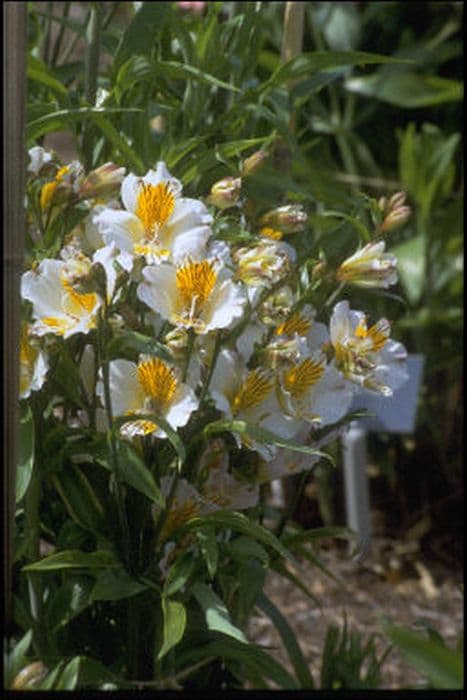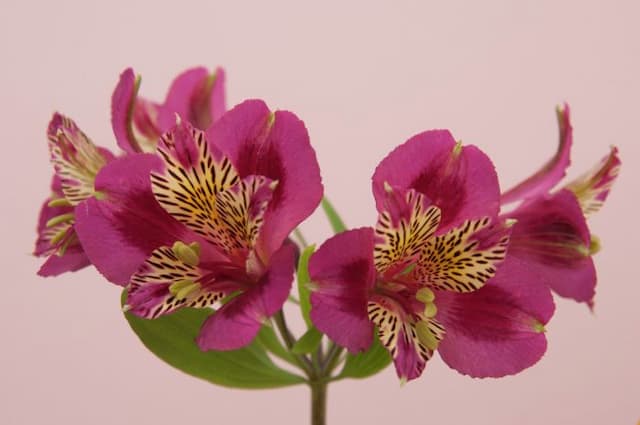Peruvian Lily Alstroemeria 'Pandora' (PBR)

ABOUT
Alstroemeria 'Pandora', also commonly known as the Peruvian Lily or Lily of the Incas, is a stunningly beautiful and colorful plant that boasts a striking appearance. The Peruvian Lily displays a vibrant mix of flowers, usually featuring shades of pink, purple, and cream with unique, streaky markings that often resemble whiskers. The petals exhibit a smooth texture and are typically curved outward, giving the flowers a characteristic flared look. Inside the throat of the flower, you can frequently find contrasting speckles or streaks that draw the eye deeper into the bloom. The leaves of Alstroemeria 'Pandora' grow in a lance-shaped manner, with a glossy green surface that complements the brightness of the flowers. They are arranged alternately along the stems, which are sturdy and upright. The foliage often twists so that the bottom side faces up, which is a unique feature of Alstroemeria plants. The plant has a clump-forming habit, meaning that it grows in a dense, compact group, giving it a lush and full appearance. It creates a visually pleasing mass of both colorful flowers and attractive green foliage, which is excellent for filling in garden beds or as part of a floral arrangement. The Peruvian Lily typically blooms from late spring to early summer, providing a long-lasting display of enchanting beauty that can brighten up any space.
About this plant
 Names
NamesFamily
Alstroemeriaceae.
Synonyms
Peruvian Lily, Lily of the Incas, Parrot Lily.
Common names
Alstroemeria 'Pandora' (PBR)
 Toxicity
ToxicityTo humans
Alstroemeria, also known as the Peruvian lily or lily of the Incas, generally has a low level of toxicity to humans. While they are not considered highly poisonous, ingesting parts of the plant can cause mild gastrointestinal upset, such as nausea, vomiting, or diarrhea. It's important to note that the sap of the plant can cause skin irritations and dermatitis in some individuals due to the presence of tulipalin, a skin irritant. Therefore, it would be wise to handle the plant with care and wash hands after contact to prevent any potential skin reactions.
To pets
Peruvian lily can be moderately toxic to cats and dogs if ingested. The primary concern is the potential for gastrointestinal upset, which may present symptoms like vomiting, diarrhea, and abdominal pain. While it is not typically life-threatening, if you suspect your pet has eaten a significant amount of the plant and is showing symptoms, it is advisable to contact your veterinarian for further guidance. Generally, keeping the Peruvian lily out of reach of pets is recommended to prevent any possible discomfort or issues arising from its ingestion.
 Characteristics
CharacteristicsLife cycle
Perennials
Foliage type
Deciduous
Color of leaves
Green
Flower color
Mixed
Height
2-3 feet (60-90 cm)
Spread
2 feet (60 cm)
Plant type
Bulb
Hardiness zones
7
Native area
South America
Benefits
 General Benefits
General Benefits- Attractive Flowers: Alstroemeria 'Pandora' is well-loved for its showy, funnel-shaped, and often two-toned flowers that add a splash of color to gardens and floral arrangements.
- Long Bloom Period: It has a long flowering season, providing color and interest from late spring to early autumn.
- Drought Tolerance: Once established, this plant has good tolerance to short periods of drought, reducing the need for frequent watering.
- Low Maintenance: It requires minimal care once established, needing only occasional watering and fertilization.
- Attracts Pollinators: The flowers attract bees, butterflies, and other pollinating insects, helpful for garden pollination and biodiversity.
- Versatile Use: Suitable for borders, containers, and as a cut flower, allowing use in various garden designs and indoor decoration.
- Perennial Growth: As a perennial, Alstroemeria 'Pandora' comes back year after year, making it a cost-effective addition to the garden.
 Medical Properties
Medical Properties- This plant is not used for medical purposes.
 Air-purifying Qualities
Air-purifying QualitiesThis plant is not specifically known for air purifying qualities.
 Other Uses
Other Uses- Photography and Painting Inspiration: The intricate patterns and vibrant colors of the Alstroemeria 'Pandora' make it a favorite subject for photographers and painters wishing to capture natural beauty.
- Educational Tool: Botany educators can use the complex reproductive system and hybrid characteristics of Alstroemeria 'Pandora' to teach about plant genetics and breeding.
- Perfume Industry: While not commonly used, the subtle scent of Alstroemeria 'Pandora' can be used as inspiration for creating unique floral fragrances.
- Crafting: The sturdy stems and long-lasting flowers make Alstroemeria 'Pandora' suitable for creating dried flower arrangements and potpourri.
- Gastronomy: Although not a typical edible flower, some chefs use the petals of Alstroemeria 'Pandora' as a colorful garnish for haute cuisine, after ensuring they are free of pesticides and safe for consumption.
- Fashion Design: The color patterns of the Alstroemeria 'Pandora' can serve as inspiration for textile patterns and designs in the fashion industry.
- Wedding Decor: Alstroemeria 'Pandora' can be used in creating bridal bouquets and other wedding decorations due to its symbolism of devotion and mutual support.
- Art Classes: Art schools occasionally use Alstroemeria 'Pandora' to teach students about shading and color blending techniques, due to the flower's diverse pigmentation.
- Seasonal Celebrations: Alstroemeria 'Pandora' is sometimes used in festivals or celebrations as a symbol of friendship and prosperity, especially in events that emphasize floral displays.
- Container Gardening Education: Alstroemeria 'Pandora' is used as an example in container gardening workshops to show how to grow and care for perennials in pots.
Interesting Facts
 Feng Shui
Feng ShuiAlstroemeria, commonly known as Peruvian Lily or Lily of the Incas, should be placed in areas of the home that correspond to wealth and abundance, such as the southeast, due to its vibrant, abundant flowers which can attract good fortune and positive energy, according to Feng Shui principles.
 Zodiac Sign Compitability
Zodiac Sign CompitabilityThe Peruvian Lily is not used in astrology practice.
 Plant Symbolism
Plant Symbolism- Friendship: Alstroemeria, also known as the Peruvian lily or lily of the Incas, is often associated with deep bonds and a strong connection between friends.
- Devotion: The intricate patterns on the petals symbolize the commitment and devotional aspects one person holds for another.
- Wealth: The abundant flowering and colorful appearance of the Peruvian lily can represent prosperity and wealth.
- Achievement: The hardiness and resilience of the plant mirror the idea of striving and achieving success through persistence.
- Longevity: Since Alstroemeria can last long after being cut, they symbolize the endurance of life and long-lasting relationships.
 Water
WaterThe Princess Lily prefers consistently moist soil, so it's important to water it when the top inch of soil begins to dry out. In general, this may mean watering approximately once a week with about one to two gallons of water, depending on the climate and the plant's environment. It's crucial not to let the soil become waterlogged, so ensure proper drainage. During hot, dry periods, the frequency may increase, while in cooler, cloudy weather, it may decrease. Always check the soil moisture before watering to avoid overwatering.
 Light
LightThe Princess Lily thrives in full sun to partial shade. The ideal spot would provide it with at least 6 hours of sunlight each day, which fuels its vibrant blooms and growth. However, it also benefits from some afternoon shade in extremely hot climates, which helps protect it from heat stress.
 Temperature
TemperaturePrincess Lilies perform best in temperatures ranging between 65 to 80 degrees Fahrenheit, making them suitable for a wide range of climates. They can survive short periods of colder weather but are not frost tolerant, with a minimum temperature threshold of around 45 degrees Fahrenheit. To ensure healthy growth, protect the plants from extreme temperatures, which can stress or damage them.
 Pruning
PruningPrune the Princess Lily to encourage bushier growth and more blooms, removing spent flowers and trimming lightly as needed. The best time for pruning is at the end of the blooming cycle, typically in late fall. Do not cut back more than a third of the plant at once, and ensure your tools are clean to prevent the spread of disease.
 Cleaning
CleaningAs needed
 Soil
SoilPeruvian Lily requires a well-draining soil mix with a slightly acidic to neutral pH, ideally between 6.0 and 7.0. A combination of potting soil, peat or coconut coir, and perlite or sand is suitable to ensure good drainage and aeration. Adding organic matter like compost can also enhance the soil's fertility.
 Repotting
RepottingPeruvian Lilies should be repotted every 2 to 3 years, or when they become root-bound. The best time for repotting is in the spring, before the new growth starts, to minimize stress on the plant.
 Humidity & Misting
Humidity & MistingPeruvian Lily thrives in moderate humidity levels; aim to maintain humidity around 40-50%. It is not particularly demanding but avoiding excessively dry air can help keep its foliage healthy.
 Suitable locations
Suitable locationsIndoor
Place in bright, indirect light with some direct sun.
Outdoor
Plant in partial shade with shelter from strong winds.
Hardiness zone
7-10 USDA
 Life cycle
Life cycleThe life of the Alstroemeria 'Pandora', commonly known as the Peruvian Lily or Lily of the Incas, begins with seed germination or vegetative reproduction through division of tuberous rhizomes. After germination, the seedlings establish themselves and develop into a rosette of leaves, and the plant's root system expands with tuber formation. As it grows, the plant produces tall, upright stems adorned with lance-shaped leaves and eventually, the characteristic clusters of showy, funnel-shaped flowers known for their striking patterns and colors emerge during the flowering season. Following pollination, these flowers develop into capsule-like fruits that contain seeds, completing the reproductive cycle. After flowering, the plant may enter a period of dormancy, particularly in colder climates, where foliage dies back, and the plant survives underground through its rhizomes until favorable conditions return. With proper care, the Peruvian Lily can rebloom several times throughout the growing season, often with a reduction in plant vigor after several years, necessitating division to rejuvenate and propagate the plant.
 Propogation
PropogationPropogation time
Spring-Early Summer
The Alstroemeria 'Pandora', commonly known as Peruvian Lily or Lily of the Incas, is best propagated through division, which is usually done in the late winter or early spring before new growth begins. To propagate by division, carefully dig up the clump of tubers and rhizomes, making sure to keep a good amount of soil around the roots. Gently separate the clump into smaller sections, each with at least one or two growth points or shoots. Replant the divisions at the same depth they were growing at previously, spacing them about 12 to 18 inches (approximately 30 to 45 centimeters) apart to give them room to grow. Water the new divisions thoroughly after planting to help establish them. This method is favored as it maintains the characteristics of the parent plant and allows for the rapid production of new plants.






![Peruvian lily [Inca Coral]](/_next/image?url=https%3A%2F%2Fplants-admin.emdemapps.com%2Fimages%2Fplants%2F%2Fimages%2F604b5b79b85ce.png&w=640&q=75)
![Peruvian lily [Inca Exotica]](/_next/image?url=https%3A%2F%2Fplants-admin.emdemapps.com%2Fimages%2Fplants%2F%2Fimages%2F604b5ec0e34a9.png&w=640&q=75)
![Peruvian lily [Inca Milk]](/_next/image?url=https%3A%2F%2Fplants-admin.emdemapps.com%2Fimages%2Fplants%2F%2Fimages%2F604b5f14b0b6a.png&w=640&q=75)
![Peruvian lily [Inticancha White Pink Blush]](/_next/image?url=https%3A%2F%2Fplants-admin.emdemapps.com%2Fimages%2Fplants%2F%2Fimages%2F604b538014919.png&w=640&q=75)